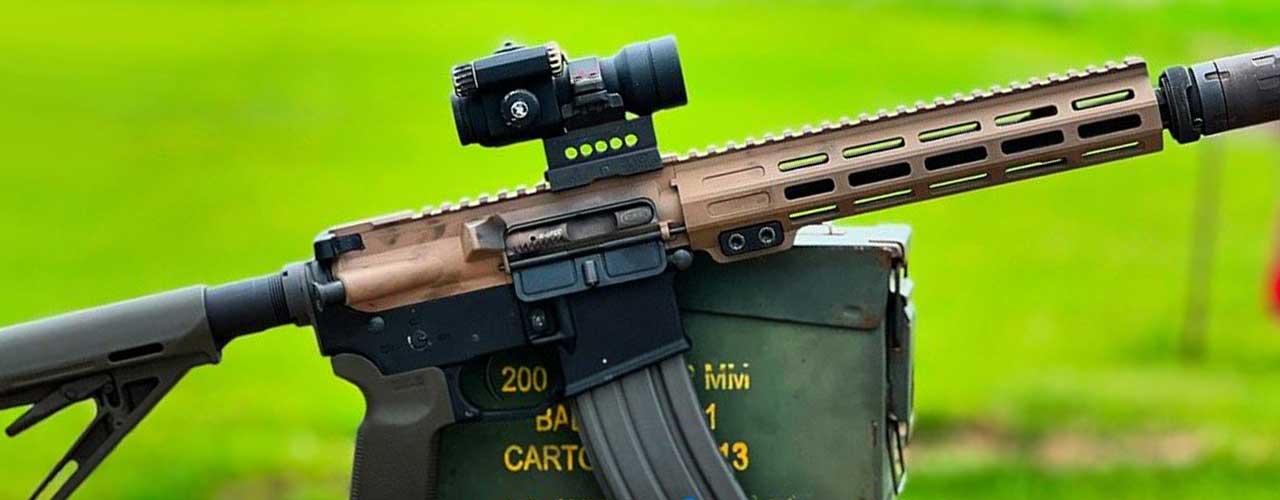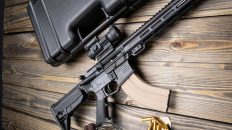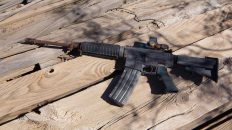When it comes to the world of AR-15 firearms, there’s a hidden danger lurking beneath the surface: carbon buildup. Most gun owners are aware of the importance of cleaning their firearms regularly, but many underestimate the consequences of neglecting this crucial task. In this article, we will dive into the truth about carbon buildup in firearms, uncovering the potential hazards it can pose and the measures one can take to prevent it.
Carbon buildup occurs when combustion byproducts, such as unburned gunpowder and primer residue, accumulate over time inside the barrel, chamber, and other crucial components of a firearm. The result? Reduced accuracy, poor performance, and even malfunctioning firearms. Not to mention the increased risk of dangerous accidents due to misfires or explosions.
So, what can gun owners do to combat carbon buildup? From proper cleaning techniques to the use of specialized solvents and tools, we will explore the best practices for keeping your firearms in top shape. Join us as we unmask the hidden dangers of carbon buildup and equip you with the knowledge to protect yourself and your valuable firearms.
How does carbon buildup occur
Carbon buildup, also known as carbon fouling, occurs when combustion byproducts, such as unburned powder and primer residue, accumulate over time inside the barrel, chamber, and other crucial components of a firearm. Every time a bullet is fired, a small amount of residue is left behind. Over time, this residue builds up and forms a layer of carbon. This carbon layer can negatively impact the performance and reliability of the firearm.
The combustion byproducts, including carbon, can also cause corrosion if left unattended. This corrosion can eat away at the metal components of the firearm, leading to irreversible damage. Additionally, carbon buildup can restrict the movement of moving parts, resulting in a decrease in accuracy and overall firearm performance.
To prevent carbon buildup, it is essential to clean firearms regularly and thoroughly. Neglecting this crucial task can lead to significant consequences.
The impact of carbon buildup on firearm performance
Carbon buildup can have a significant impact on firearm performance. As the carbon layer thickens, it can obstruct the barrel and affect the bullet’s trajectory. This can result in reduced accuracy and inconsistency in shot placement.
Furthermore, carbon buildup can lead to an increase in chamber pressure. When the residue accumulates in the chamber, it can cause insufficient space for the cartridge to expand upon firing. This can lead to higher pressure levels, potentially resulting in malfunctions, misfires, or even catastrophic failures.
In semi-automatic firearms, carbon buildup can interfere with the cycling of the action. The residue can impede the movement of the slide or bolt, causing failures to feed, extract, or eject properly. This can lead to a decrease in reliability and an increased risk of malfunctions.
Signs and symptoms of carbon buildup
Identifying carbon buildup in firearms is crucial for ensuring their proper maintenance. There are several signs and symptoms that may indicate the presence of carbon buildup:
- Reduced accuracy : If you notice a sudden decrease in accuracy or inconsistencies in shot placement, it may be an indication of carbon buildup obstructing the barrel.
- Difficulty in cycling : If your semi-automatic firearm experiences failures to feed, extract, or eject properly, it could be a result of carbon buildup interfering with the action’s movement.
- Increased recoil : Carbon buildup can lead to increased friction and resistance within the firearm. This can result in higher felt recoil, making it harder to control the firearm during shooting.
- Failure to ignite : Carbon buildup can obstruct the firing pin or the primer pocket, leading to misfires or failures to ignite.
Recognizing these signs early on can help gun owners take prompt action to address carbon buildup and prevent further damage to their firearms.
The dangers of neglecting carbon buildup
Neglecting carbon buildup in firearms can have severe consequences, both for the firearm itself and the shooter. One of the most significant dangers is the increased risk of misfires or explosions. If the residue obstructs the firing pin or primer pocket, the firearm may fail to ignite the primer properly, resulting in a misfire. In some cases, this can lead to a delayed ignition or a hangfire, where the cartridge ignites after a noticeable delay.
Furthermore, carbon buildup can lead to increased chamber pressure, as mentioned earlier. The higher pressure levels can cause the firearm to malfunction, resulting in potentially dangerous situations. The excess pressure can lead to ruptured cases, blown-out barrels, or even catastrophic failures, putting the shooter and those nearby at risk of injury.
Neglected carbon buildup can also cause corrosion, especially if the residue contains corrosive compounds. Corrosion can eat away at the metal components of the firearm, compromising its structural integrity and potentially rendering it unsafe to use.
Cleaning and maintenance techniques to prevent carbon buildup
Regular cleaning and maintenance are essential to prevent carbon buildup and ensure the longevity and reliability of firearms. Here are some techniques to consider:
- Field stripping : Field stripping involves disassembling the firearm to its major components, such as the slide, barrel, and frame. This allows for easier access to the areas where carbon buildup is most likely to occur. Follow the manufacturer’s instructions or consult a professional if you are unsure about the disassembly process.
- Brushing and scrubbing : Use a brass or nylon brush, along with a suitable solvent, to scrub away the carbon buildup. Pay close attention to the barrel, chamber, and other areas where residue tends to accumulate. Be thorough but gentle to avoid damaging the firearm.
- Patches and swabs : After brushing, use patches or swabs soaked in a solvent to further clean the surfaces. This helps remove any remaining residue and ensures a thorough cleaning.
- Inspection and lubrication : Once the cleaning is complete, inspect the firearm for any signs of damage or wear. Apply a suitable lubricant to ensure smooth operation and protect against future carbon buildup.
It is important to note that different firearms may require specific cleaning techniques and products. Always consult the firearm’s manual or seek professional advice if you are unsure about the cleaning process.
For more information on cleaning and maintaining firearms, check out our section on firearm maintenance.
Recommended cleaning products for removing carbon buildup
Choosing the right cleaning products can make a significant difference in effectively removing carbon buildup. Here are some recommended products to consider:
- Bore solvent : A bore solvent specifically designed for firearms can effectively dissolve carbon and other residues. Look for solvents that are safe for use on the specific type of firearm you own. Here is a great article listing the Top 7 Solvents for Removing Carbon.
- Bronze or nylon brushes : Bronze or nylon brushes are suitable for scrubbing away carbon buildup without damaging the firearm’s surfaces. Choose the appropriate brush size for the caliber of your firearm.
- Cleaning patches and swabs : Use high-quality cleaning patches or swabs to remove carbon residue from hard-to-reach areas. These patches should be absorbent and non-linting to ensure a thorough cleaning.
- Lubricant : After cleaning, apply a high-quality lubricant to protect against future carbon buildup and ensure smooth operation. Look for lubricants specifically designed for firearms.
Remember to follow the manufacturer’s instructions when using cleaning products and always prioritize safety during the cleaning process.
Professional services for carbon buildup removal
In some cases, carbon buildup may be too severe or challenging to remove through regular cleaning techniques. In such situations, it may be necessary to seek professional help. There are specialized services available that can thoroughly clean and remove carbon buildup from firearms. A simple Google search for a firearm cleaning service should get you started.
Professional firearm cleaning services often utilize advanced cleaning methods, such as ultrasonic cleaning, to effectively remove carbon and other residues. These services can help restore the firearm’s performance and ensure its safe operation.
If you are unsure about the extent of the carbon buildup or lack the necessary tools and expertise, it is advisable to consult a professional firearm cleaner. They can assess the condition of your firearm and provide the appropriate cleaning and maintenance required.
Tips for preventing carbon buildup in firearms
Preventing carbon buildup in firearms is crucial for maintaining their performance and reliability. Here are some tips to help gun owners minimize carbon buildup:
- Regular cleaning : Clean your firearms regularly, even if they haven’t been fired. Regular cleaning helps remove any accumulated residue and prevents the buildup of carbon.
- Immediate cleaning after use : After shooting, clean your firearms as soon as possible. The longer the residue sits, the harder it becomes to remove.
- Use quality ammunition : High-quality ammunition tends to produce less residue, reducing the chances of carbon buildup. It is worth investing in reputable brands that prioritize cleanliness and consistency.
- Proper storage : Store your firearms in a clean and dry environment. Moisture can accelerate the corrosion process, making it easier for carbon buildup to occur.
- Follow manufacturer recommendations : Always follow the manufacturer’s recommendations for cleaning and maintenance. Different firearms may have specific requirements that should be followed for optimal performance.
By implementing these preventive measures, gun owners can significantly reduce the risk of carbon buildup and ensure the longevity of their firearms.
Conclusion: Importance of regular cleaning and maintenance to prevent carbon buildup
Carbon buildup in firearms is a hidden danger that can have serious consequences. From reduced accuracy and poor performance to the risk of malfunctions and dangerous accidents, neglecting carbon buildup can compromise both the firearm and the shooter’s safety.
Regular cleaning and firearm maintenance are crucial to prevent carbon buildup and ensure the reliable operation of firearms. By understanding the causes and dangers of carbon buildup, gun owners can take the necessary precautions to minimize its occurrence.
Remember to follow proper cleaning techniques, use recommended cleaning products, and seek professional assistance when needed. With proper care and attention, you can unmask the hidden dangers of carbon buildup and keep your firearms in top shape for years to come. Stay safe and happy shooting!





Why are you using made up terms that describe a nonexistent situation? There is no such thing as a misfire in a firearm. Not a thing. If you think it is, prove it. A misfire is when an internal combustion engine fails to fire whether intermittently or regularly. The misfire is easily noticed and diagnosed and is typically a plug or wire issue, occasionally a distributor cap issue and can be a few more things in modern computer times vehicles. In a firearm the absolute closest thing is a failure to fire, (light primer strike, or a dud). I get you want subscribers and acting authoritative aids that goal but lying puts people in far more danger than carbon. I have personally torture tested multiple of my firearms by not cleaning them and firing until they stop being reliable. I have a S&W semiauto pistol that ran over 1000 before I got my first failure to return to battery. I would say reasonable. I have an AR that’s long surpassed the 1000 round count between cleanings and kept on going. Yes what a mess when I did break it down to clean but it was just carbon, no metal flaking and with such tight tolerances it would have failed to chamber before magically filling the throat enough to exceed the limitations of the barrel and bolt. Lots of carbon in the fire control group too but eh, no biggie. I have been present for many firearm failures including a catastrophic failure that left someone bruised and bleeding. They include overpressure, failure to feed, failure to fire, failure to eject and even failure to extract. Had bullets pull out of cases and stick in the chamber. Heard of the dread delayed ignition called SEE secondary explosive effect caused by using certain powders in too low of volume for the case. Never heard of a catastrophic way for failure to fire to happen. I supposed if you are in a defensive aituation and pull the trigger and it doesn’t work old black Bart might well wreck your day. Burst barrels, broken bolt locking lugs, receiver locking lug setback happen by over pressure. This happens from SEE, from over charging a cartridge, and from bore obstructions and yes if there’s a hang fire the bullet can become the obstruction. Don’t keep spreading misinformation, it’s as irritating as calling cartridges “bullets”.
Hi Yo Momma,
Thank you for taking the time to read my article and share your insights. I appreciate your passion for firearms and your detailed response.
Regarding the terminology, “misfire” is indeed a recognized term in the context of firearms. It refers to a situation where the primer fails to ignite the propellant, resulting in the cartridge not firing. This term is commonly used interchangeably with “failure to fire” within the firearms community.
I understand your point about personal experience with carbon buildup. Many firearms can endure significant buildup before experiencing major issues. However, my article aims to highlight the importance of regular maintenance to ensure long-term reliability and safety. While some firearms may continue to function with considerable buildup, regular cleaning helps maintain accuracy and prevents potential malfunctions, even if not immediately catastrophic.
Your perspective and experiences are valuable, and I appreciate you sharing them. My goal is to provide comprehensive information to help all gun owners keep their firearms in optimal condition.
Thanks again for your feedback!